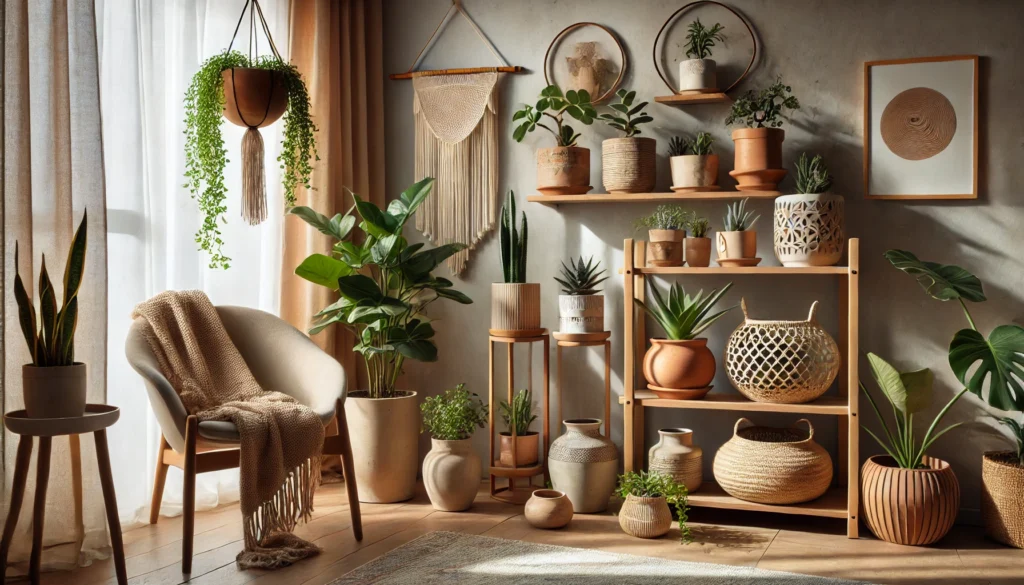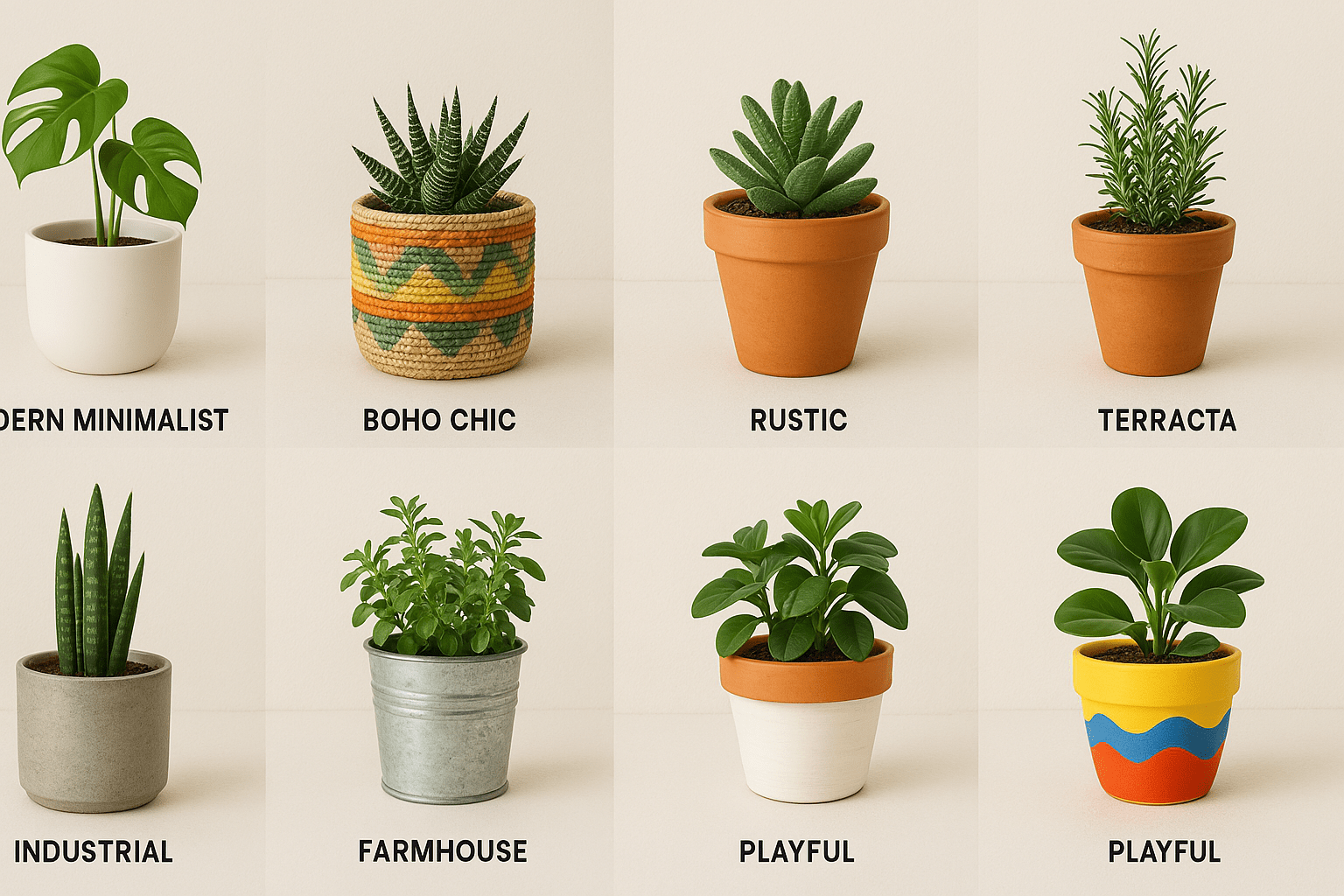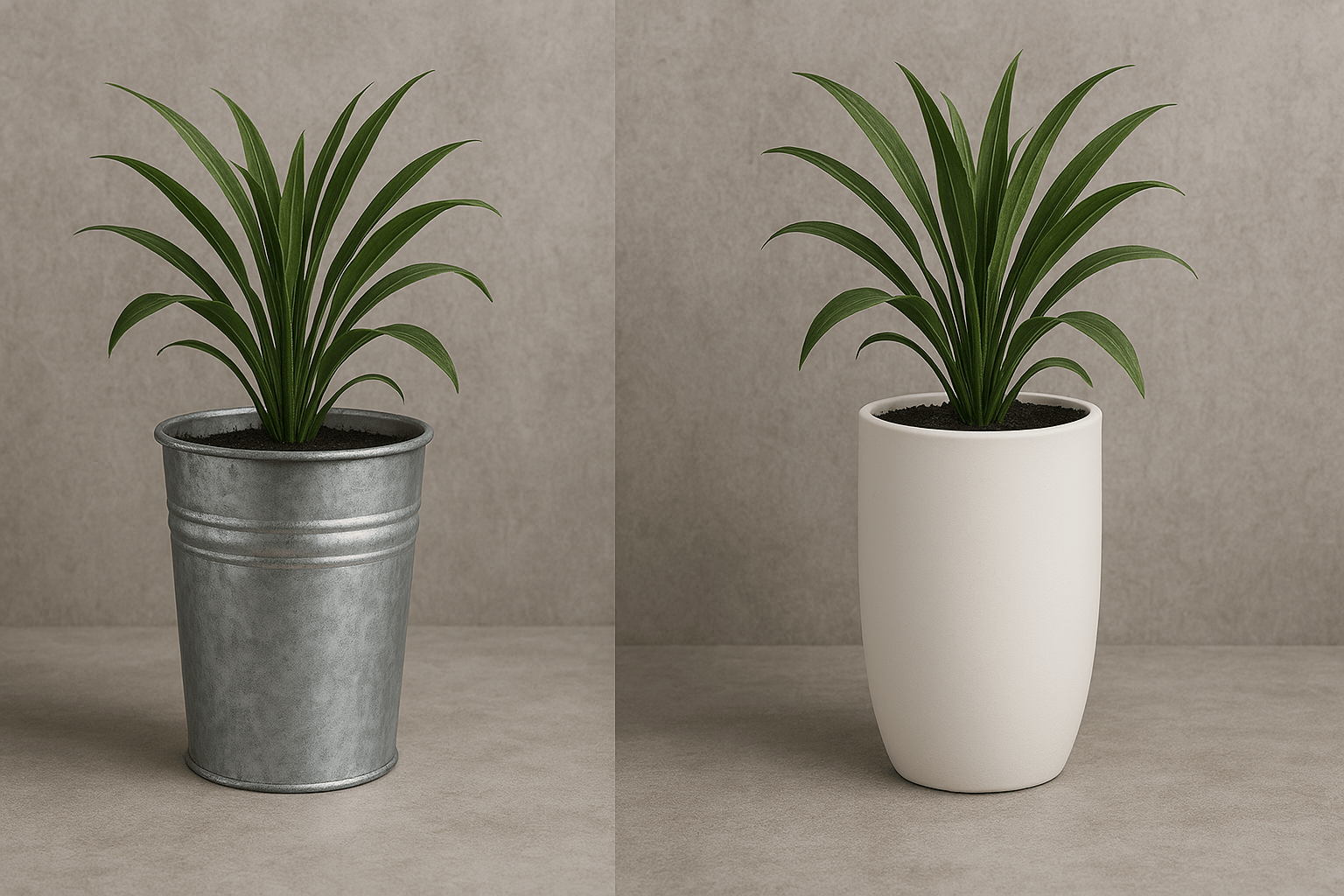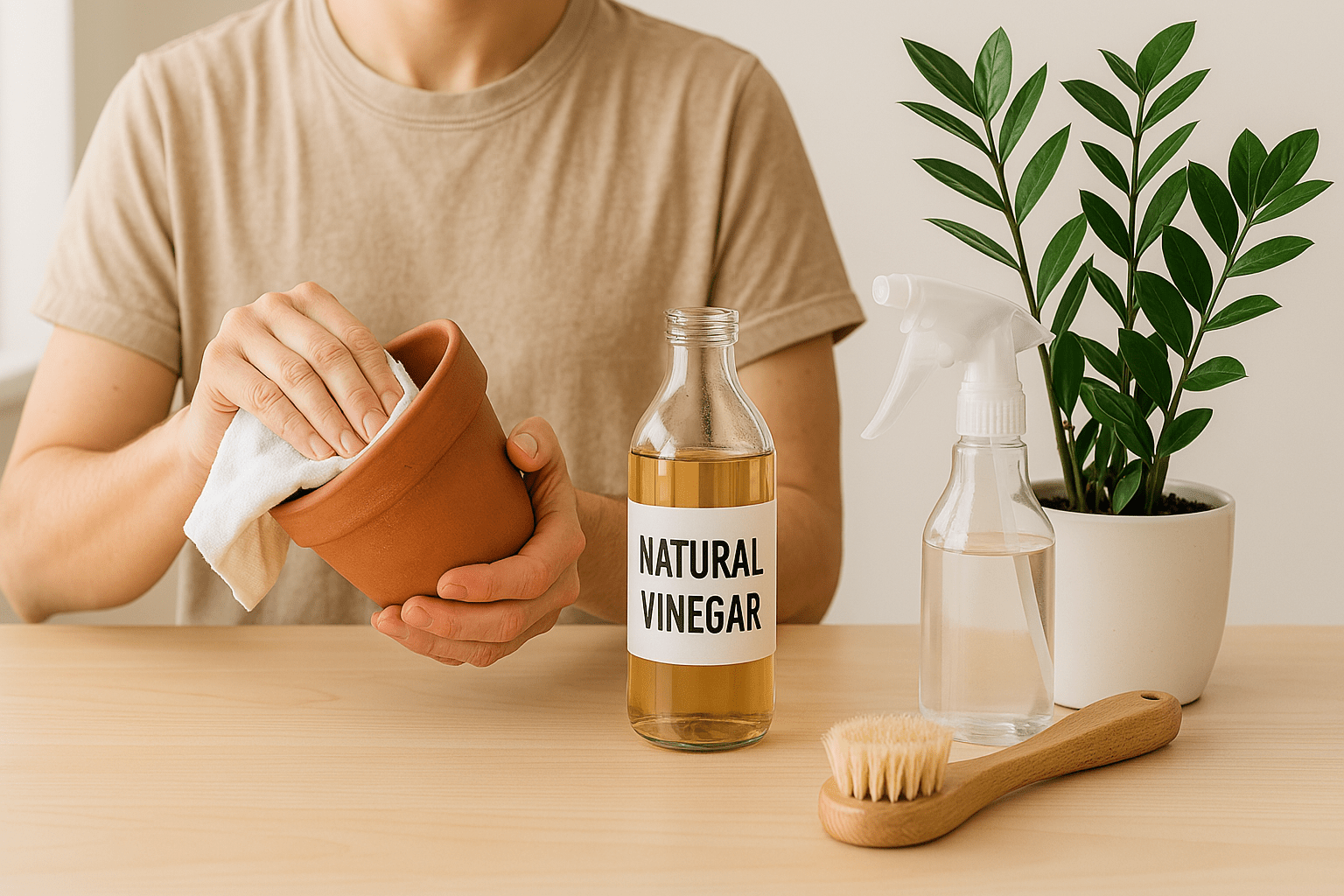
Choosing Decorative Pots and Planters: A Guide to Enhance Your Home's Style
Imagine transforming a dull corner of your living room into a vibrant oasis with just a few plants. The secret isn’t just in the greenery but in choosing decorative pots and planters that complement both your plants and your home’s style. Whether you’re a seasoned plant parent or a beginner, selecting the right pots can make a world of difference. Not only do they elevate the visual appeal of your plants, but they also play a vital role in their overall health and growth. In this guide, we’ll explore how choosing decorative pots and planters can enhance your home’s décor while supporting your plants’ needs.
Table of Contents
ToggleFactors to Consider When Choosing Pots and Planters
When it comes to choosing decorative pots and planters, there are a few key factors that can make a big difference in both the aesthetic and health of your plants. Let’s break them down:
Material Matters 🌿
The material of your pot affects both its look and functionality. Common options include:
- Ceramic: Stylish and heavy, perfect for large plants but may require a saucer to catch excess water.
- Plastic: Lightweight and budget-friendly, but might not offer the same aesthetic appeal.
- Metal: Sleek and modern, but can get hot under the sun—ideal for indoor plants.
- Wood: Gives a rustic look and is breathable, but might need regular sealing to avoid rotting.

Size and Proportions 📏
The right size pot is crucial for plant health. A pot that’s too small restricts root growth, while one that’s too large can lead to waterlogged soil. As a rule of thumb, choose a pot that’s 1-2 inches larger in diameter than the current root ball of your plant. 🪴
Drainage Is Key 🌊
Proper drainage is essential to prevent water from sitting in the pot, which can lead to root rot. Look for pots with drainage holes or consider drilling your own if necessary. 🌱
Color and Style 🎨
Your pot should reflect your home’s décor. Neutral colors like white, black, or terracotta work well in almost any space. If you want to add a pop of personality, go for bold, colorful pots that match the vibe of your room. Don’t forget—light-colored pots reflect sunlight, which helps with plant growth, while darker pots absorb heat.
Weight and Mobility 💪
Consider the weight of the pot, especially if you plan to move it around. Ceramic pots can be heavy, while plastic ones are lighter and easier to transport. Choose what works best for your space and mobility needs.
By keeping these factors in mind, you can make an informed decision when choosing decorative pots and planters that will both beautify your space and nurture your plants! 🌻
Matching Pots to Your Plant’s Needs
When choosing decorative pots and planters, it’s important to consider not only your home’s style but also your plant’s specific needs. Each plant has its own requirements for growth, and the right pot can make all the difference. Here’s how to match pots to your plant’s needs:
- Plant Size 🌱
- Large plants like fiddle leaf figs or snake plants need bigger pots to allow their roots to spread. Choose pots that are 2-3 inches larger than the plant’s root ball.
- Small plants like succulents or cacti thrive in smaller, shallow pots. Too much soil can cause overwatering, so stick to pots that are just a bit bigger than the roots.
- Drainage for Health 💧
Proper drainage is a must for most plants. Plants like succulents and cacti prefer pots with great drainage to prevent water from sitting in the soil, while plants like peace lilies or fern may do well in pots that retain moisture but still allow excess water to escape. Always choose pots with drainage holes unless you’re using a decorative pot inside a larger pot.
- Pot Depth 🏺
- Shallow pots work well for plants with short roots, like succulents or aloe vera.
- Deeper pots are necessary for plants with long roots, such as tomatoes or indoor trees like the rubber plant.

- Moisture Retention 🌧️
Some plants prefer consistently moist soil, like tropical plants (think monstera and ferns). A glazed ceramic pot works well for these since it holds moisture longer. For plants that need less moisture, such as cacti or succulents, go for terra cotta pots, which dry out faster.
- Aesthetic vs. Functionality 🎨💡
While it’s tempting to pick a pot based on looks alone, always remember your plant’s needs should come first. For instance, a gorgeous metal pot may look stunning, but it could get too hot for sensitive plants in direct sunlight. Make sure the pot you choose allows your plant to thrive while enhancing your décor.
By choosing pots that align with your plant’s specific requirements, you’ll ensure they grow happily and healthily while adding beauty to your space! 🌿
Design Styles for Decorative Pots and Planters

When choosing decorative pots and planters, the design plays a big role in enhancing your home’s overall aesthetic. The right pot can perfectly complement your interior style and bring out the beauty of your plants. Here are some popular design styles to consider:
Modern Minimalism 🖤
- Look: Sleek, simple, and clean lines.
- Materials: Matte ceramics, concrete, or metal with neutral colors like white, black, or grey.
- Perfect For: Plants like snake plants, pothos, and ZZ plants that match the clean, modern vibe of minimalistic décor.
- Tip: Stick to single-color pots for a streamlined look that doesn’t distract from your plant’s beauty.

Boho Chic 🌸
- Look: Earthy, eclectic, and relaxed with a touch of whimsy.
- Materials: Woven baskets, textured ceramics, and colorful designs.
- Perfect For: Ferns, philodendrons, and monstera that thrive in cozy, laid-back environments.
- Tip: Mix and match different textures and colors for a bohemian feel. Think hanging planters or macramé hangers!

Rustic and Vintage 🧡
- Look: Weathered finishes and a charming, lived-in vibe.
- Materials: Terra cotta, wood, or distressed metals for a timeless feel.
- Perfect For: Herbs, lavender, and succulents that love sunlight and a bit of rustic charm.
- Tip: Use terracotta pots for a classic rustic touch. They also help your plants breathe and drain moisture effectively.

Industrial 🏗️
- Look: Bold, raw, and modern with an urban edge.
- Materials: Concrete, steel, or matte-black metal.
- Perfect For: Cacti, succulents, and other hardy plants that don’t need excessive watering.
- Tip: Pair industrial pots with large leafy plants like rubber trees to contrast with the clean, industrial look.

Farmhouse 🌻
- Look: Cozy, charming, and often oversized for a welcoming feel.
- Materials: Galvanized metal, aged wood, or neutral-colored ceramics.
- Perfect For: Fiddle leaf figs, indoor herbs, and climbing vines that add to a farmhouse-inspired décor.
- Tip: Use large, statement pots to anchor plants in the room and create a natural, inviting vibe.

Colorful & Playful 🌈
- Look: Bright, fun, and full of personality.
- Materials: Glazed ceramics, painted pots, or funky patterns.
- Perfect For: Bright-colored flowers, calatheas, and maranta to match the cheerful vibe.
- Tip: Experiment with contrasting colors for a playful feel or choose pots that match the colors of your plants for a coordinated look.

By choosing a design style that suits both your plants and your home’s décor, you’ll create a space that’s both functional and beautiful! 🌿✨
Caring for Your Decorative Pots
Once you’ve selected the perfect decorative pots and planters, proper care will help keep them looking beautiful while ensuring your plants thrive. Here’s how to take care of both your pots and plants:
Cleaning Your Pots 🧼
To keep your decorative pots sparkling, regular cleaning is a must:
- Ceramic and Terracotta: Use a damp cloth to wipe away dust and dirt. For stubborn stains, a mixture of vinegar and water can help.
- Plastic Pots: Clean with warm, soapy water and rinse thoroughly. Avoid harsh chemicals that may damage the material.
- Metal Pots: Wipe with a soft cloth to prevent rust. If rust develops, gently scrub with steel wool or a rust remover.

Preventing Water Damage 💧
Excess water can cause damage to your floors or furniture. Here’s how to manage:
- Use Saucers: Always place a saucer under your pot to catch excess water.
- Pot Liners: Consider using liners if your decorative pot doesn’t have drainage holes.
- Watering: Be mindful not to overwater. The right pot with proper drainage will help prevent water from pooling at the bottom.
Long-term Care 🌟
Even the best pots can get worn over time:
- Cracks: If your decorative pot cracks, it might be time for a replacement. However, smaller cracks in ceramic or terracotta pots can be sealed with waterproof sealant.
- Color Fading: Pots left in direct sunlight for long periods may fade. Rotate pots occasionally to keep them from sun damage or opt for UV-resistant ones for outdoor use.
Maintaining Drainage 🕳️
Proper drainage is essential for plant health:
- Check Holes: Ensure drainage holes are clear and not clogged with soil or debris. This allows water to flow freely, preventing root rot.
- Re-potting: As your plant grows, you might need to repot it into a larger pot with appropriate drainage.
By maintaining your decorative pots and planters, you’ll extend their lifespan while also supporting the growth of your plants. Regular cleaning, proper drainage, and protecting from water damage are all key to keeping both your plants and pots healthy! 🌿💚
Where to Place Your Pots and Planters
The placement of your decorative pots and planters plays a crucial role in both the aesthetics of your space and the health of your plants. Here’s how to choose the perfect spots for your pots to thrive:
Indoor Placement 🏠
- Near Windows: Most plants, especially succulents, herbs, and spider plants, need plenty of natural light. Place them on windowsills or nearby to give them the sunlight they need.
- Bright, Indirect Light: For plants like monstera or peace lilies, place them in areas with bright, indirect light. Avoid direct sunlight to prevent leaf burn.
- Shelves and Tables: For small plants like cacti or air plants, a tabletop or shelf can be a great spot. They add an element of design without taking up too much space.
- Hanging Planters: Use macramé hangers or wall-mounted shelves for trailing plants like pothos or string of pearls. This adds greenery without cluttering floors.
Outdoor Placement 🌳
- Patios and Balconies: If you have outdoor space, place larger plants like rubber trees or palms in stylish pots to add life to your patio or balcony. Choose weather-resistant pots made from materials like concrete or plastic.
- Full Sun vs. Shade: Some plants, like succulents and cacti, thrive in full sunlight, while others like ferns or hostas prefer shady spots. Always consider your plant’s light needs when placing them outside.
- Hanging Baskets: Hanging planters are perfect for creating a layered effect, especially with flowering plants or vines. They also keep plants out of the reach of pets and children.

Temperature Considerations 🌡️
- Avoid Extreme Heat or Cold: Always consider temperature extremes. Avoid placing pots in areas that get too hot (like near radiators) or too cold (near drafty windows or doors), as it can affect your plant’s growth and health.
- Outdoor Pots in Winter: For outdoor pots, make sure they are made of materials that can handle freezing temperatures, like thick plastic or concrete. Terracotta pots may crack if left outside in freezing conditions.
Grouping Pots Together 🌿
- Create a Focal Point: Grouping plants together in different-sized pots can create a beautiful display. Mix tall plants with smaller ones for contrast and depth.
- Elevate and Layer: Place some pots on plant stands or tables to add height and dimension to your display. This works well for both indoor and outdoor spaces.
By strategically placing your decorative pots and planters, you’ll not only improve the overall look of your home but also provide your plants with the ideal conditions for growth. 🌱
DIY and Customization Ideas
If you’re looking to add a personal touch to your decorative pots and planters, DIY projects and customization are a great way to express your style while making your plant displays unique. Here are some fun and easy ideas to get creative:
Painted Pots 🎨
- Simple Designs: Use acrylic paint to create bold stripes, geometric shapes, or polka dots on plain ceramic or terracotta pots. Choose colors that match your room’s décor for a cohesive look.
- Watercolor Effect: For a more subtle and artistic design, create a watercolor effect by blending two or more colors together on the pot. This is perfect for a relaxed, boho vibe.
- Stencil Art: Use stencils to add intricate patterns or designs to your pots. You can find stencils in various shapes, from floral to abstract, allowing you to personalize your pots to match your style.
Natural Materials 🪵
- Wrap Pots in Twine or Rope: Give your pots a rustic or coastal look by wrapping them in jute twine, hemp rope, or even colorful yarn. You can glue it around the pot or create a criss-cross pattern for added texture.
- Wooden Planter Box: Turn an old wooden crate or a pallet into a stylish planter box. Sand and stain it for a vintage look, then line it with a plastic insert to keep the soil contained.
Upcycled Pots ♻️
- Teacups, Mugs, or Bowls: Turn old teacups, mugs, or small bowls into cute planters. These are perfect for small plants like succulents or herbs. Simply drill a small hole in the bottom for drainage and add your plant!
- Old Cans or Bottles: Repurpose old tin cans, glass bottles, or mason jars as planters. Spray paint them, add a little decorative trim, or cover them in fabric to make them more stylish.
Macramé Hanging Planters 🧶
- Create Your Own Hanger: If you enjoy knotting, try making your own macramé hangers. These DIY planters are perfect for trailing plants like pothos or string of hearts. You can customize the length and color to match your space.
- Add Beads or Tassels: Customize your macramé with beads, tassels, or other decorations to add texture and personality to your plant display.
Concrete Planters 🏗️
- Make Your Own: If you’re feeling adventurous, try making concrete planters at home. You can pour concrete into molds or use two different-sized containers to create a modern, industrial look.
- Decorate with Paint or Gold Leaf: Once your concrete planter is dry, add a touch of glam with gold leaf accents, metallic paints, or a simple color wash to give it a chic, modern vibe.
Personalized Plant Markers 🌿
- Label Your Plants: Create custom plant markers to match your pots! Use materials like wood, stones, or even popsicle sticks. Paint them with the plant’s name or add fun designs to help identify your plants while enhancing your pot’s charm.

DIY and customizing your decorative pots and planters not only adds a personal touch to your home but also makes your plants feel even more special. Whether you’re using recycled materials or getting crafty with paint and rope, these easy and creative projects will enhance your plant collection in a way that’s uniquely yours! 🌻🎉
Whether you opt for a minimalist look, a cozy farmhouse style, or get creative with DIY projects, there are endless ways to personalize your planters to match your taste. Remember, the key is to find the perfect balance between aesthetics and functionality, ensuring your plants have the ideal environment to thrive.
By following these tips, you can not only elevate the look of your home but also build a stronger connection with your plants—creating a space that’s both stylish and green! 🌿💚
Frequently Asked Questions (FAQ)
How do I choose the right pot for my plant and home décor?
Match the pot’s size to your plant’s needs and choose materials, colors, or textures that complement your interior style.
What materials are best for decorative indoor planters?
Ceramic, terracotta, metal, concrete, and woven baskets are all popular options depending on the look you want.
Do decorative pots need drainage holes?
Ideally, yes. If not, place your plant in a nursery pot inside the decorative one to allow proper drainage.
How can I style different pots together in a room?
Use varying heights, colors, and shapes within a consistent color scheme or material for a cohesive look.
Are plastic pots suitable for home décor?
Yes, especially when placed inside a decorative cover pot or basket to add visual appeal.
How do I pick planter colors that match my room?
Neutral tones work well in any space, while bold colors or patterns can add a pop of personality and contrast.
What’s the difference between indoor and outdoor planters?
Indoor planters are often more decorative and may lack drainage, while outdoor ones are built for durability and weather resistance.
Can I use baskets or unusual containers as planters?
Yes, as long as they’re lined properly or used as decorative covers over a functional plant pot.
